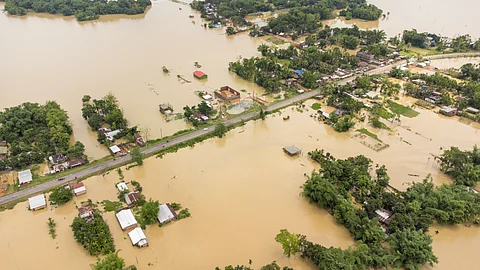

Meghna river basin spans 82,000 sq km and sustains 50 million people in India and Bangladesh.
Monsoon rainfall declining; pre- and post-monsoon rains increasing, raising flash flood risks.
Over 50% of the basin faces rising temperatures; early-season floods threaten Bangladesh’s Haor wetlands.
Anthropogenic pressures—mining, sand extraction, wetland conversion—exacerbate ecosystem fragility.
Experts call for nature-based solutions, forest and wetland restoration, and cross-border data sharing.
The climate crisis is reshaping the hydrology of the Barak-Meghna basin — an 82,000 sq km lifeline for over 50 million people in India and Bangladesh. Experts warn that monsoon rainfall is declining, while pre- and post-monsoon showers are increasing, triggering flash floods and threatening the communities like the indigenous Khasi, Garo and Jaintia who rely on the river’s ecosystem.
These findings emerged from a three-day dialogue, “Building Community and Ecosystem Resilience to Climate Change,” hosted by the Meghna Knowledge Forum II from July 23-25 in Bangkok. The event was organised by the International Union for Conservation of Nature (IUCN) with South Asian University (New Delhi) and the Asian Institute of Technology (Bangkok).
Experts noted that the Barak-Meghna basin is witnessing more frequent and intense extreme precipitation events, accompanied by an increase in flash floods. Over half of the basin is experiencing rising temperature trends.
For example, the Haors (wetlands) in Bangladesh's Sylhet division may face high-intensity flash floods if average April rainfall exceeds 250 mm in Meghalaya and Assam, India, and 400 mm in Sylhet, Bangladesh.
If current trends continue, the river basin will see shifts in rainfall patterns: pre-monsoon and post-monsoon rainfall are already increasing, while monsoon rains are declining, particularly in north-eastern India.
This inter-seasonal shift will alter the timing and intensity of floods, heightening the risk of early-season flash floods in Bangladesh’s Haor region. Pre-monsoon flash floods, in particular, impact Meghalaya and Assam, damaging the haor wetlands and causing extensive crop and fish losses in Bangladesh.
With current emission trajectories, India risks jeopardising its forests and wetlands, with more than 10 per cent of ecosystems projected to be at very high risk by 2050.
The WWF’s Living Planet Report 2024 showed an 85 per cent decline in freshwater species populations since 1970, while the United Nations Office for Disaster Risk Reduction reported a 134 per cent rise in flood-related disasters since 2000, with droughts affecting 55 million people annually.
Researchers highlighted that the basin hosts high species richness, including endemic and migratory fish, amphibians and aquatic plants.
Beyond climate change, human disturbances such as sand mining, deforestation and water diversion are further undermining the stability of these ecosystems.
In the Indian stretch of the river, mining in Thingou (upper zone) and from Jatinga to Ranighat (middle zone), along with extensive fishing and heavy ferry traffic from Jirimukh to Sonabarighat, are disrupting the ecosystem.
In Bangladesh, habitat degradation, fragmentation, encroachment, and the conversion of wetlands to agricultural land are impacting freshwater biodiversity at Tanguar and Hakaluki Haor. Overexploitation of fisheries, unsustainable use of forests and birds, dam and bridge construction, unplanned tourism and pollution further threaten the ecosystem.
Civil society members, policymakers, academics and indigenous organisations stressed the need to strengthen community resilience in the river basin.
Participants suggested that trade and tourism could offer sustainable solutions, as both countries are engaged in formal and informal trade. Goods such as fruits, fish, bay leaves, betel nuts, spices like black pepper, bamboo products, pineapples and jackfruit remain in high demand.
Homestay tourism is also growing, with festivals such as Shillong’s Cherry Blossom Festival, the Me’gong Festival and the Taisam Festival on the Simsang riverbank, alongside fishing tourism showcasing local crafts, food and culture, all attracting visitors and boosting local economies.
Researchers called for a resilient Meghna river basin built around nature-based climate solutions to safeguard freshwater ecosystems, support local economies and empower communities through scientific engagement.
Participants also emphasised the need to establish research and capacity-building networks between India and Bangladesh to generate knowledge, train youth and institutions, and develop integrated policies.
The three-day dialogue encouraged private sector participation in building community resilience and contributing to ecosystem restoration. Experts urged the protection and restoration of forests, wetlands and haors as natural defences against floods and droughts, through investment in nature-based and ecosystem-based adaptation strategies.
The event further underlined the crucial role of women, indigenous peoples and rural youth, who are disproportionately vulnerable to climate risks. Experts recognised that policies and finance must be timely, inclusive and prioritise local adaptation, enhancing community capacities.
These lessons and strategies should be incorporated into national and subnational plans, alongside cross-border collaboration such as joint early warning systems, data sharing and coordinated disaster risk management, to mitigate the growing risks of droughts, flash floods and ecosystem degradation.